|
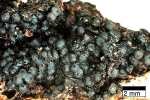
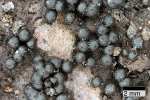
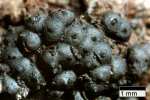
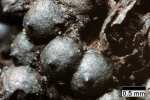
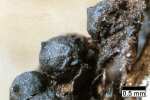
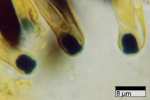
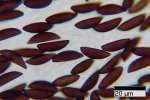
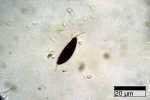
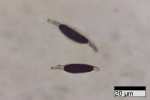
|
Rosellinia thelena (Fr.: Fr.) Rabh.
Stromata usually densely gregarious, uniperitheciate, rarely fused
together in a 2-3- peritheciate stroma, dark brown to black with a thin coating
of pale subicular hyphae, subglobose with a broadly attached base, 0.8-1 mm diam,
with conspicuous folds and ridges in the lower part when dry; ectostroma rather
thin, brittle; subiculum densely felted, purplish brown, of finely
interwoven hyphae, persistent, widely spreading.
Ostioles stout, broadly conical, darker than the stromatal wall.
Asci cylindrical, with apical apparatus urn-shaped with
attenuated base, amyloid, 5.5-7.5 µm high x 4.5-5.5 µm broad.
Ascospores 19-26.5 x 6-8 µm, ellipsoid-inequilateral to
slightly oblong with broadly rounded ends, dark brown, with a straight germ slit nearly spore-length
to 3/4 spore-length on the less convex side; both ends with a spiny cellular appendage 5-10 µm long.
Anamorph in nature: not seen.
Specimens examined: FRANCE: Ariège (09): Massat, Forêt
de Bellissens, 24 Aug. 1999, JF-99192, on bark of a trunk of Abies alba;
Prades, Forêt Domaniale, Bois de Font Frède, 1200 m, 28 Sept. 1997, JF-97169,
on bark of Abies alba; Rimont, Las Muros, 08 Aug. 1997, JF-97128/1, on
twigs and needles of Picea abies; Rimont, Las Muros, ruisseau de Peyrau,
30 Aug. 1999, JF-99195, on bark of Quercus robur; Rimont, Las Muros,
ruisseau de Peyrau, 25 Nov. 2003, JF-03235, on bark of Alnus glutinosa;
Salau, mine d'Anglade, 09 Jul. 2000, JF-00115, on bark of Fagus sylvatica.
SWITZERLAND.
Les Diablerets, 26 Aug. 1993, JFM-9354, on Picea.
Notes: Rosellinia thelena is representative of the
subgenus Corrugata with its thin-walled stromata with stout ostioles
and ridges in the lower part, seated on a felted widespreading subiculum. It
is easily distinguished from R. desmazieresii and R. mycophila
by its long, pointed cellular appendages at both ends of ascospores. Rosellinia
thelena var. microspora is likewise very similar but merely differs
from the typical variety in having smaller perithecia and shorter ascospores.
Ascospores of R. thelena exhibit variations in shape, dimensions
and germ slit length, but the pointed cellular appendages up to 10 µm long are
conspicuous and distinctive, allowing an unambiguous identification.
Rosellinia thelena is typically associated with recently dead
wood, twigs or needles ofconifers, but likewise occurs on wood of deciduous
trees. This feature is most unusual within the Xylariaceae, where host-specificity
for conifers is rare but apparently respected. Rosellinia thelena has
been reported as endophyte (Petrini, 1993) from healthy looking conifers, that
could explain why it develops so rapidly on recently fallen branches if environmental
requirements, mostly a constant humidity, are satisfied.
Rosellinia thelena is known from Europe and North America (Petrini,
1993).
|